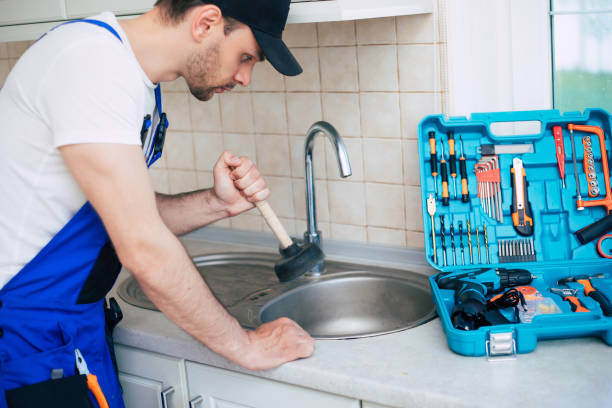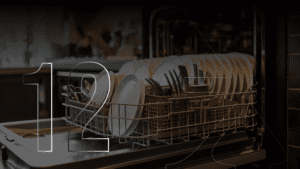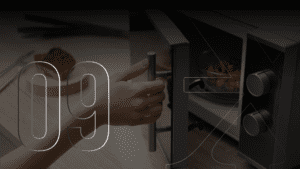A clogged kitchen sink is one of the most common household problem. Whether you’re washing dishes after dinner or prepping for a meal, nothing feels worse than seeing water refuse to drain. The scenario becomes even trickier when you have a rubbish disposal related issue, seeing that each system is connected, one clog can have an effect on the alternative.
But don’t worry! In most cases, you may fix the difficulty yourself without calling a plumber. All you want is some staying power, a few basic tools, and a touch of expertise.
In this guide, you’ll get to know how to restore a clogged kitchen sink with a disposal, what causes the hassle, and a way to prevent it in the future, all in an easy, safe and step by step method.
Understanding Why Your Kitchen Sink Gets Clogged
The question that no owner of a house wants to ask, but one that is, alas, not unusual. Kitchen sink clogs can arise for a number of reasons but they’re most often because of a buildup of food residue, grease, cleaning soap scum, and special particles collecting inside the drain.
- Grease and oils: When poured down the drain, they harden and stick in the pipes.
- Food scraps: Items like potato peels, pasta, coffee grounds, and rice clump collectively without problems.
- Fibrous veggies: Celery, onion skins, and corn husks can wrap across the disposal blades.
- Foreign objects: Accidentally dropping utensils or bottle caps can jam the device.
- Overloading: Putting an excessive amount of food waste at once clog the motor and drainage system.
When your kitchen sink is clogged, you can be aware of the status of water accumulating in the basin, or its far too slow draining. This can be very inconvenient, specifically while there are last night’s dishes to do! However, the best news is that there are numerous strategies for unclogging a kitchen sink that you can attempt before calling a plumber.
What You’ll Need to Unclog Your Sink
- Rubber Gloves: Protect your fingers from grease and sharp edges whilst working in the sink or disposal.
- Plumber’s Wrench: Helps loosen or tighten the nuts maintaining the drain pipe.
- Bucket: Place it underneath the sink to capture any water or particles at the same time as cleansing the pipe.
- Plunger: A cup-style plunger can help create suction and clear minor clogs correctly.
- Drain Snake: A flexible device for putting off stubborn clogs deeper inside the drain; disposable variations are also available.
- Old Toothbrush: Useful for scrubbing and cleaning the inside of the drain entrance.
- Rags: Handy for sealing the plunger, wiping spills, and cleaning up afterward.
- Flashlight or Phone Light: Helps you notice internal dark areas of the drain at the same time as operating.
Safety Precautions
- Unplug the disposal or switch off the power from the circuit breaker.
- Never place your hand inside the disposal unit, the blades are sharp and may still flow even though powered off.
- Avoid harsh chemical drain cleaners. They could probably dissolve the clog, but they can also damage your pipes and the disposal’s steel components.
Step-by-Step Guide: How to Fix a Clogged Kitchen Sink with Disposal
Let’s go step-by-step through the most effective methods you can try at home.
Step 1: Check Inside the Drain
Start by examining the drain using a flashlight. If you can see any food waste, debris, or foreign item inside, use pliers or kitchen tongs to carefully pull it out.
Never attain it along with your palms, despite the fact that the power is off. Once you’ve cleared what’s visible, run water to see if it drains nicely.
Step 2: Reset the Disposal
If your disposal isn’t working at all or is creating a humming sound, the reset button may also have tripped.
- Find the purple reset button under the disposal unit.
- Press it once.
- Turn on water and switch the disposal back on.
Sometimes, this quick repair restores ordinary features right away.
Step 3: Run Cold Water
Always use cold water while running your disposal. It helps solidify any grease or oil, permitting the blades to grind them down more correctly.
Run the disposal for about 30 seconds with cold water to test if the blockage loosens.
Step 4: Use Baking Soda and Vinegar
This eco-friendly cleaning combo works wonders without damaging your pipes.
- Pour ½ cup of baking soda into the drain.
- Add 1 cup of white vinegar.
- Let the aggregate bubble for 10–15 minutes.
- Flush the drain with hot water.
This now not only facilitates break down grease and food residue but also gets rid of ugly odors.
Step 5: Try a sink plunger
If the clog continues to be there, it’s time for a touch test.
- Fill your sink with some inches of water.
- Place a sink plunger (not a restroom plunger) over the drain.
- Seal it tightly and pump up and down for 15–20 seconds.
- Remove the plunger and spot if the water drains.
For double sinks, plug one aspect with a wet cloth to preserve suction.
Step 6: Clean the P-Trap
If plunging doesn’t assist, the clog can be within the P-trap, the U-style pipe below your sink.
- Place a bucket underneath to capture any water.
- Loosen the slip nuts and dispose of the entire piece.
- Clean out particles or buildup with the use of a brush or wire.
- Reattach the trap and test by way of strolling water.
This is regularly where most cursed clogs hide.
Step 7: Manually Rotate the Disposal Blades
If your disposal hums but doesn’t spin, the blades are probably jammed.
- Use an Allen wrench (hex key) and insert it into the small hole below the disposal.
- Gently flip the wrench from side to side to loosen the blades.
- Remove the wrench, restore electricity, and run cold water at the same time as testing the disposal.
You should listen; the blades flow freely again.
Step 8: Flush the Drain Thoroughly
Once the whole thing is working again, run warm water for a minute to cast off any leftover debris and grease.
This ensures that your pipes are clean and sparkling, preventing future buildup.
Easy Maintenance Tips to Prevent Future Clogs
Avoiding clogs is tons less complicated than solving them. Follow these guidelines:
- Always run cold water earlier than and after the usage of the disposal.
- Never pour oil, grease, or fat down the drain.
- Avoid fibrous ingredients like corn husks, onion skins, and celery.
- Cut large meal scraps into smaller pieces before grinding.
- Once a week, grind ice cubes and lemon peels to clean and refresh the unit.
- Regular upkeep not only best prevents clogs but also continues your disposal clogging efficiently for years.
If your disposal still won’t work after following all of the steps, or in case you hear grinding noises or smell burning odors, it’s time to call a plumber. They can test for deeper plumbing troubles or advise an alternative in case your unit is wiped out.
Conclusion
A clogged kitchen sink with a disposal may seem frustrating; however, it is smooth to restore with the proper steps. Regular cleaning and right use save you from future blockages. If your old disposal isn’t performing properly, upgrading to a modern Xpert Appliances model ensures smoother operation. With simple care, you could preserve your kitchen smooth, green, and hassle-free.
FAQs – Fixing a Clogged Kitchen Sink with Disposal
Q1: Why does my sink still smell after cleansing?
There may be residue stuck beneath the blades. Run the disposal with lemon slices and baking soda for freshness.
Q2: My disposal is buzzing but now not spinning. What do I need to do?
Turn off the electricity and use an Allen wrench at the bottom of the unit to manually unfasten the blades.
Q3: Are chemical drain cleaners secure for disposal?
No, avoid them. They can corrode the disposal’s inner additives and harm the pipes.
Q4: When must I replace my disposal?
If it leaks, jams regularly, or is over 10 years old, replacement is often more value-powerful than restoration.




